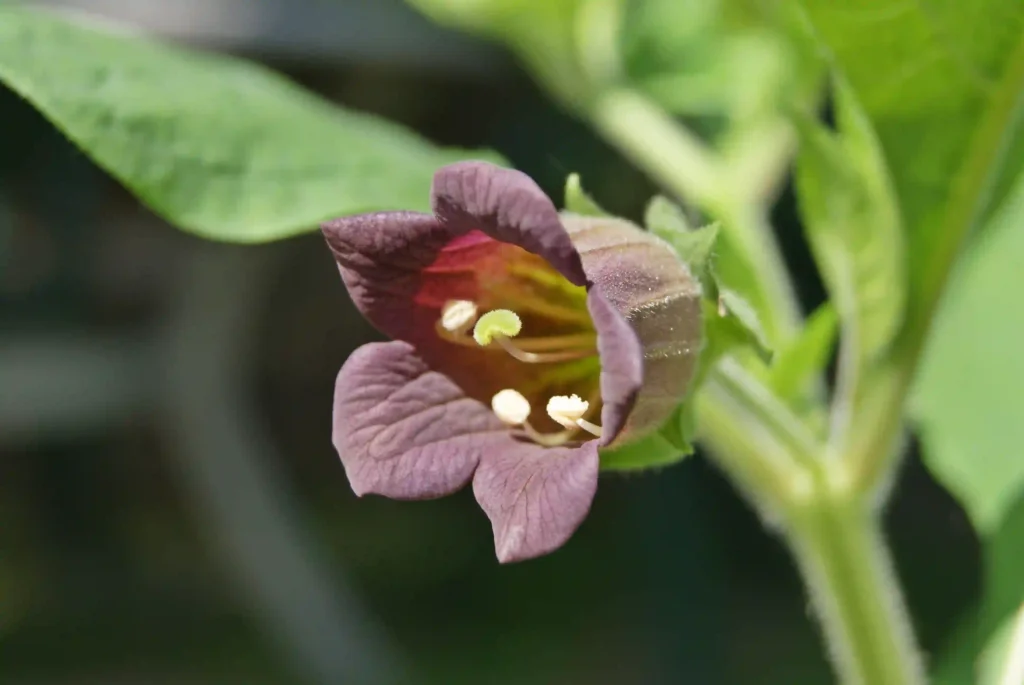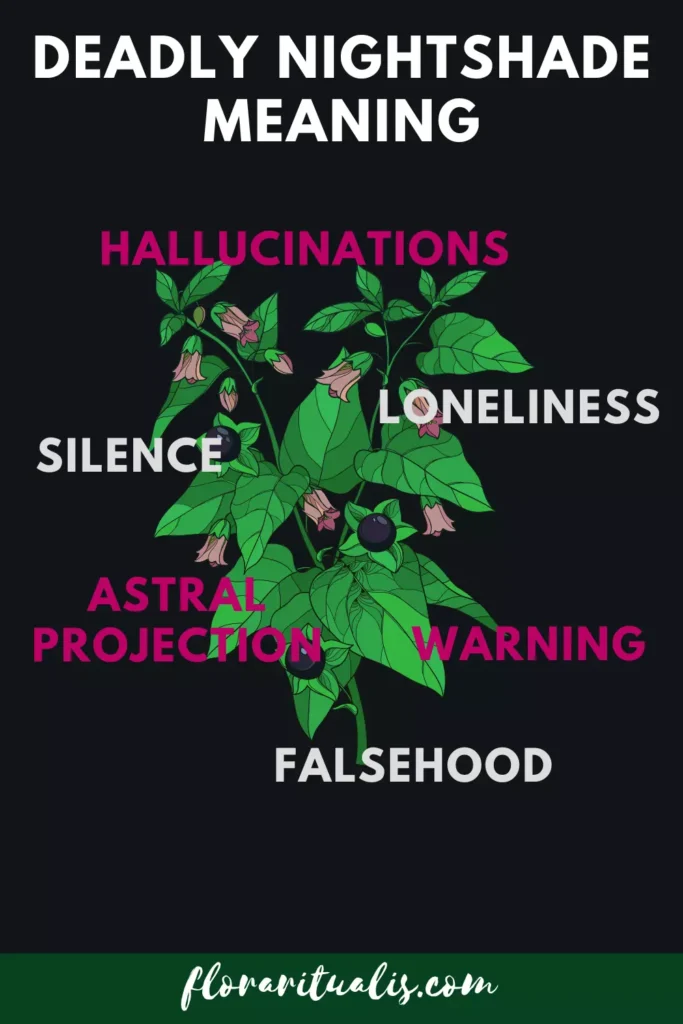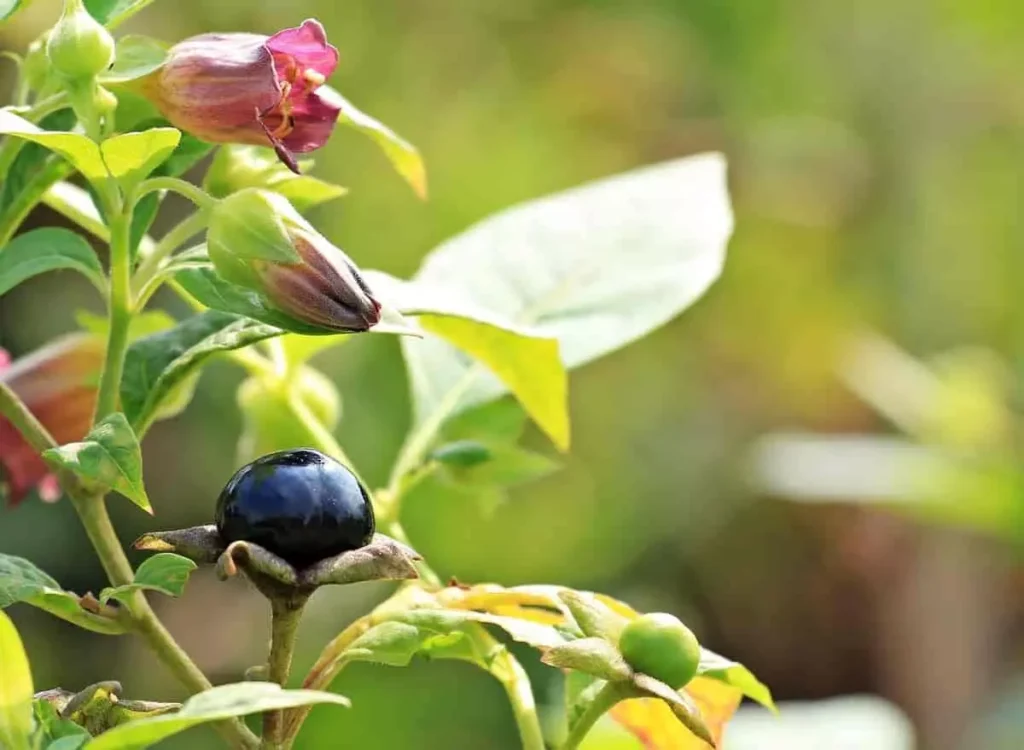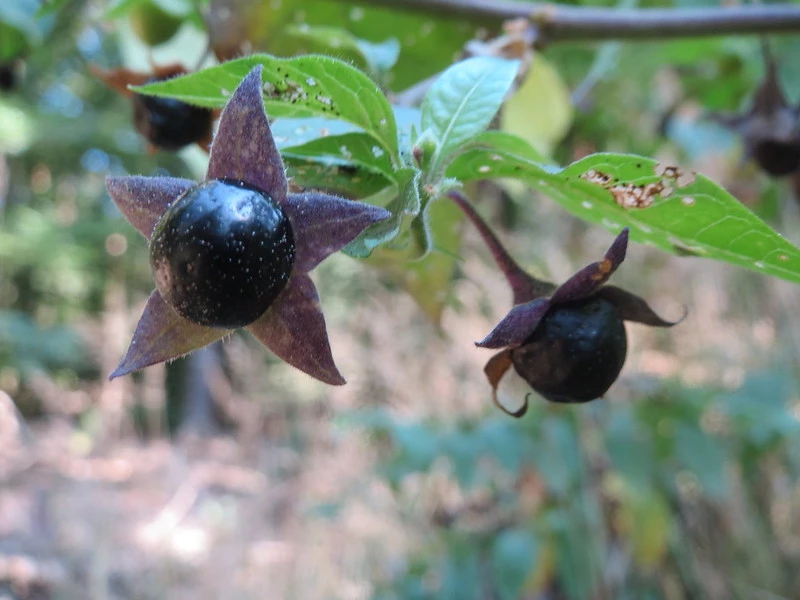Have you been wondering about the deadly nightshade plant meaning?
This fascinating plant holds a deep history and meaning to it, in this blog we’ll explore this plant in depth.
The plant is also called Atropa Belladona and due its toxic properties it has also been called Devil’s Herb, Devil’s Cherry or Poison Black Cherry.
It is from the Solanaceae family and this also includes a variety of other plants like eggplants, tobacco and tomatoes. It is also considered as a weed.
What does the deadly nightshade symbolises?
The Deadly Nightshade or the Atropa Belladona symbolises falsehood, loneliness and silence. The potential powers from this plant are Astral projection, Hallucinations and visions. Alchemists place this plant under the dominion of Saturn.
This makes the deadly nightshade of the birth flowers of Capricorn and Aquarius.
But that’s not all despite the plant being toxic the deadly nightshade was also used as a medicinal plant. Read on to learn more.
Deadly nightshade meaning in mythology
The name of the deadly nightshade comes from a Swedish naturalist named Carl Linnaeus in the 18th century.
He named the plant after the one of the Greek fates. In Greek mythology the fates are Clotho who spins the thread of human life, Lachesis who measures the thread of human life and Atropos the eldest of the fates who cuts the thread of human life.
The word Belladonna comes from Italy and translates to “beautiful lady,” this name referred to the use of the plant in the 16th century.
Fashionable women of Venice during that time used the juice of the plant as drops to dilate their pupils.

The eyes are often called the windows to the soul and the dilation was also a phenomenon that occurred during arousal. Therefore, this practice made eye contact more intense, however, it also caused glaucoma.
There was also a belief that the Greek god Dionysus was also linked to the plant.
The worshippers of Dionysus would dissolve the deadly nightshade in wine in order to induce trances of dancing and sexual activities.
The plant was also rumoured to have taken the life of the Roman soldiers who were retreating from the Parthians.
Just like any poisonous plant there was also a relationship to the goddess Hecate, the goddess presiding over magic and spells. Witches would therefore use the plant in their formulas.
The plant of Witches
There are two formulas that use deadly nightshade in their ointment, they were both written by the 16th century physician Della Porta.
- De la Bule, de l’Acorum vulgaire, de
Quintefeuille, du sang de chauvesouris, de la
Morelle endormante, de l’huyle. - De graisse d’enfant, de sue d’Ache, d’Aconite,
de Quintefeuille, de Morelle, et de suye.
There have been other records of Belladonna Atropa in Witchcraft. The witches would anoint themselves with crushed leaves of the plant combined with aconite.
This would induce excitement and irregular heartbeat and it would eventually induce a state of astral projection which gave the feeling of flying.
Atropine can be absorbed by skin and it was also noted as a medicine by the usage of belladonna plasters.
This ointment was also reproduced by scientists and they have recorded the experience of their dreams in which they were flying in spirals.
Moreover, people who have accidentally ingested the deadly nightshade have also imagined themselves transforming into animals and the sensation of growing fur.
The beliefs of the deadly nightshade in history
There is an old superstitious belief that the plant would take the form of an irresistible enchantress and she would be dangerous to look at.
Another old belief was linked to werewolf. The extensive use of the drug from the plant would cause zoomorphic paranoia.
The plant was also used as an aphrodisiac during Medieval times. However, taken in large doses it would lead to irresponsible sex and also hallucinations.

Beliefs of the Belladonna Atropa in Europe
In the region of Normandy, there was a belief that anyone who would walk bare feet over the deadly nightshade plant would go insane.
Another belief from the Highlands of Scotland was that people would use the plant in order to see ghosts.
A superstition in Ireland revolved around the juice extracted from the plant that they would be make into a drink. Then whoever drank the juice would believe anything that was said by the person who made them drink it.
The plant is also called the Devil’s Herb and it was believed that the way to acquire it was for a farmer to lose a black hen on Walpurgis Night. Then the devil would chase that hen which would make him distracted enough for the farmer to acquire the plant.
In the book History of Scotland by George Buchanan there was a description of the Swedish army using the deadly nightshade.
They were required to supply the beer in order to call a truce with the armies of the Sweno the Dane. However, the beer was tainted with the deadly nightshade. This made them sleep soundly and it would later be called “sleep nightshade.”
Svein Knutsson was the king of Norway between 1030 and 1035. He lost his men when they were killed in their drugged sleep after drinking mead.
This story will also become an important one in William Shakespeare’s play Macbeth.
Medicinal properties
Up until the 20th century in Warwickshire the leaves of the deadly nightshade were used to relieve rheumatism.
It was prescribed by Herbalists for the treatment of diarrhoea and also to treat Parkinson’s disease.
Plasters made from the Belladonna Atropa plant were used to relieve pain from lumbago.

A magical charm was used with the more mature stems of the plant. It involved cutting up the stem into small pieces then threaded and worn as a necklace. This was used by young children in order to prevent teething fits.
The key components of the Deadly Nightshade are anticholinergic alkaloids. It first stimulates then blocks nerve impulses. This part of the nervous systems regulates the heart rate, secretion, muscle cramping etc.
The Atropa alkaloids in the deadly nightshade plant
When the Atropa alkaloids was given in controlled doses it would have the following effects:
- slow the action of the smooth muscle system
- reduce the symptoms of Parkinson’s disease
- irregular heart rate
- motion sickness
- asthma
- peptic ulcers
- menstrual cramps
It was also used to deal with an overabundance of bodily fluids that would cause excessive sweating, nasal mucus, diarrhea and vomiting.
History
In 1803 Andrew Duncan made a comment in the Edinburgh Dispensatory. He stated that the Belladonna Atropa would be used to relieve symptoms of several ailments. This included plague, nervous diseases and also aid in the removal of cataracts.
The Atropine compound of the plant was first isolated in 1831 by the German pharmacist A. Mein. Although A. Mein isolated the compound in 1831, the chemical uses of the Belladonna Atropa can be traced back before the Middle Ages.
He isolated the atropine from the dried belladonna root. It was then syntheised by a German chemist named Richard Willstatter in 1901.
The amount of alkaloids would depend on which part of the plant it was taken from but also on the development stage, the kind of conditions it was grown in and at what time it was harvested.
The Belladonna Atropa was best cultivated and yielded the highest concentration in dry weather and at the nighttime.
This suggested that the plant might have evolved to ward off nocturnal eaters.
The isolation of the atropine from the Belladonna plant made it possible for its use in plasters and liniments as an analgesic and counter irritant.

Uses of Deadly Nightshade in 1900’s
During the mid 19th century, those plasters and liniments were also cause for numerous poisonings. Those might have been both intentional and unintentional.
Around 1911, the death cause by atropine poisoning began to decrease until it became rare. It might have been due to the plasters and the cosmetic eye drops were banned and also obsolete.
In 1943, the Belladonna Atropa was found to be an antidote against the German tear gas used in Word War 2. However, it was never used.
In 1967, an incident occured in Tijuana, Mexico. The people ate bread that was exposed to a toxic insecticide and the Deadly Nightshade was used an antidote to save lives.
Right until the late 1960s, the plant was also a common ingredient used in birthing. It was combined with morphine to induce “twilight sleep.”
It was used as a skin patch to aid in motion sickness and also as a general anesthetic or preanesthetic agent.
The plant is native to Europe, East Asia and North Africa. However, it has also become naturalized in various parts of the world. It is even commercially cultivated and harvested in several regions in the United States and Europe as a pharmaceutical crop.
Deadly Nightshade in Homeopathy
The Deadly Nightshade was also commonly used in homeopathy remedies. It was used to treat various ailments such as:
- earaches
- fever
- menstrual cramps
- headaches
- migraines
- muscle pain
- respiratory infections

Additionally, the National Cancer Institute of Milan in Italy has conducted various research with the deadly nightshade. They have demonstrated that the homeopathic remedies of the plant provided some relief for breast cancer patients. It was for those patients would suffered from radiodermatitis.
If you have enjoyed our blog on the deadly nightshade then make sure to check out other flowers under the dominion of the planet Saturn.
FAQs Deadly Nightshade
Resources
Cumo, C. (Ed.). (2013). Encyclopedia of Cultivated Plants [3 volumes]: From Acacia to Zinnia. ABC-CLIO.
Dietz, S. T. (2022). The complete language of flowers the complete language of flowers: A definitive and illustrated history – pocket edition. Wellfleet Press.
Folkard, R. (1884). Plant lore, legends, and lyrics. Embracing the myths, traditions, superstitions, and folk-lore of the plant kingdom. S. Low, Marston, Searle, and Rivington.
Watts, D., & Watts, D. C. (2007). Dictionary of Plant Lore. Academic Press.
Deena Bsingh, a UK-born, Mauritius-raised content writer, is a dedicated explorer of the ancient world’s hidden treasures. Armed with classical studies knowledge and a decade of spiritual immersion, Deena delves deep into the wellspring of ancient wisdom. Her illuminating writings on flower meanings and culinary history are imbued with the profound insights she has gathered on her journey. Through her Medium articles, she guides readers on transformative journeys that bridge the gap between ancient cultures and contemporary consciousness, offering a rich tapestry of understanding that endures through time.

